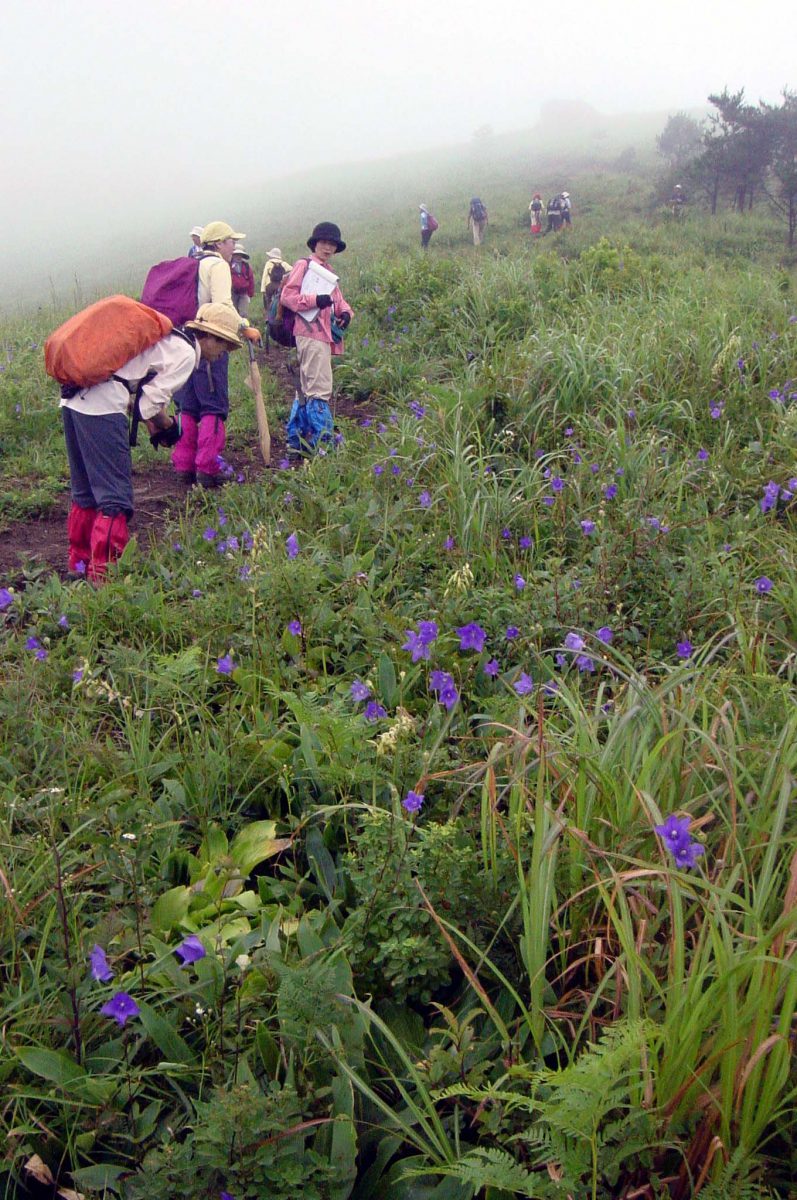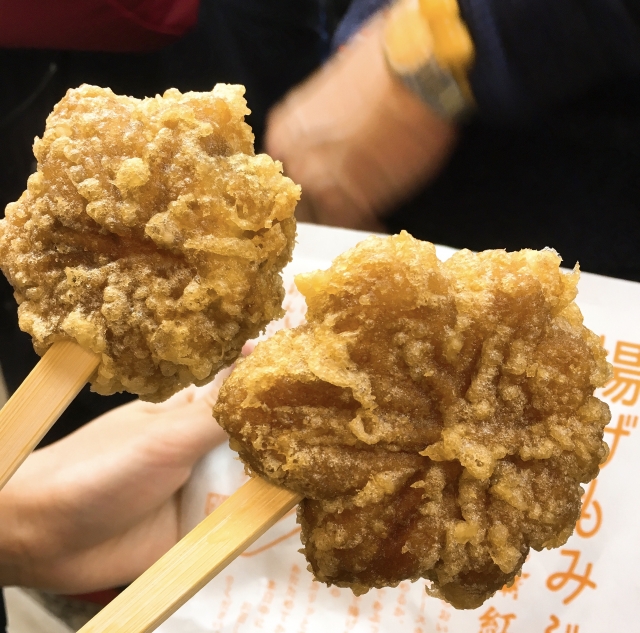Miyajima is a small and especially sacred island located just off the shore of Hiroshima city. You may know the iconic picture of the famous floating torii gate from Miyajima, it is one of the most popular and best photo spots in Japan. The island is well known as Miyajima which means shrine island, but the official name is Itsukushima. The Itsukushima Shrine is one of the most visited places in Japan and is designated as a UNESCO World Heritage Site. Next to a cultural experience, Miyajima is also an excellent place to appreciate nature, especially in autumn large crowds of tourists flock to the island to see the beautiful red, orange and yellow leaves. The island’s history goes back to ancient times when people worshiped the divinity of Mt. Misen, the highest peak of the island. In 806 AD, the prominent monk Kukai, the future founder of a Japanese Buddhist sect, ascended this spiritual mountain on the way back from China and established an ascetic site here. Then, the military leader Taira no Kiyomori gave the shrine its present Heian period style in 1168, making it a powerful Taira family shrine. All in all, there is much to do and see on the small island, here we list the best places for you to visit in Miyajima.
Special Miyajima Opportunity in October:
1. Itsukushima Shrine and the floating Torii
Because of the sanctity of the Itsukushima shrine, the entire island has become a sacred place. Depending on the tide, the scenery changes dramatically throughout the day; during the high tide, the shrine and torii gate appear to be floating on the sea, while at low tide visitors have the opportunity to walk out on the dry land right to the foot of the torii gate. The shrine consists of several different buildings; the main hall, a prayer hall, and a traditional performance stage. All are connected by wooden boardwalks. The pillars in the water support all buildings. The impressive torii is made with unprocessed camphor trees that weigh approximately 60 tons. After sunset, the shrine and the torii are wonderfully illuminated until 11 pm.


Open hours
6:30 am – 6:00 pm (March to October), 5:00/5:30 pm (November to February)
Entrance fee: ¥300 (adult)
2. Free roaming deer
Deer is everywhere in Miyajima. The island is overrun by them. They just stroll around without paying much attention to the tourists. The deer were considered sacred messengers from the gods and have been here for more than 800 years. These are usually tame and friendly enough to pet. However, please remember feeding the deer is not allowed, unlike deer in Nara Park. These deer in Miyajima are considered wild, so it’s strictly prohibited.

3. Daishoin Temple
Daishoin temple is located 5 minutes away from the Itsukushima Shrine, at the base of Mount Misen. The temple complex is spread on the slope of the mountain over a large area. Japanese Buddhist monk Kukai began the practice of Buddhism on the island in this particular spot. Along with the solemn atmosphere of the classical temple buildings, there are countless statues and a sand mandala, among other interesting objects.

The spinning wheels inscribed with the sutra are set next to the steps that lead to the temple entrance. Rotating them is believed to be the equivalent of reciting the sutra.
There are overwhelming numbers of statues at the site of the temple and there are some hidden spots, so please take some time to explore around the temple!


Open hours
8:00~5:00 pm
Entrance: free
Access: 5 min walk from Itsukushima Shrine and 15 min walk from the pier
4. Mt. Misen
The highest peak of the island, Mount Misen, is believed to be a site where the gods resided since ancient times. The mountain was opened as an ascetic holy mountain site by Kukai when underwent practice there. The fire used for the training has been kept burning in the Misen Reikado hall, called Kiezu-no-hi, meaning the eternal fire. It’s been burning for over 1,200 years and if you drink the hot water boiled by the eternal fire, it is said all illnesses will be cured. Also, this fire is used for the Flame of Peace at Hiroshima Peace Memorial Park.
On the mountain, you can find various spiritual sites. You can hike up easily, but the Miyajima Ropeway also takes you to the summit from the Momijiyama Park in 15 minutes, where there are spectacular views of the Seto Inland Sea and sometimes as far as Hiroshima City.

5. Momijidani Park
From mid to late November, the island becomes wonderfully colorful. In particular, Momijidani Park, located at the base of Mount Misen, is one of the best spots for fall colors. Momijidani Park is a 20-minute walk from the Miyajima Sanbashi Bridge and is also serviced by ferries. Seven hundred trees in vermillion, orange, and yellow make a beautiful picture of the park. The bright vermillion Momijibashi bridge, at the entrance to Momijidani Park, goes across the gorge. Without a doubt, autumn is the best season to visit Miyajima!

6. Walking Trails
Three hiking trails are leading up to Mt. Misen; the Momijidani Course, the Daishoin Course, and the Omoto Course. The Momijidani Course is the shortest but it is the steepest course going through the forest. However, this course is temporarily closed until March 2021 due to construction work. The Daishoin course consists of many stone steps and takes 1.5 to 2 hours. The Omoto course takes around 2 hours along a sloping road and stone steps. Watch your step while hiking; some parts are dangerously rocky. All over this area, are a wide variety of plants, differing in species depending on the altitude.

7. Local specialties; Momiji Manju, oyster, lemon
Though it is a small island, Miyajima has many restaurants and cafes to accommodate the daily visitors to the Itsukushima Shrine. These local eateries offer a broad range of cuisine, many of them serving up local specialties. The most popular product from Miyajima is a sweet called Momiji Manju, a maple leaf-shaped steamed bun with filling. The traditional filling is bean paste, but there are many other kinds like cream, cheese, chocolate, and big bean jam. The most popular way to eat in Miyajima, though, is a freshly deep-fried Momiji Manju. It is like a tempura but sweet, and crispy outside and soft inside.


Another specialty is freshly caught oysters. When you start to walk along Omotesando Street, the main shopping street in Miyajima, you will be surprised how many shops are grilling fresh oysters right out front. These are street foods, so just sprinkle on some ponzu (sauce made with soy sauce and citrus juice), lemon, or cayenne pepper according to your preference, and enjoy them right there. Also, you will see a lot of lemon products here, as Hiroshima produces more lemons than any other region in Japan. You may want to stop by the lemon Mojito vendor. They also serve a non-alcoholic Mojito, as well as other lemon beverages which are very refreshing. If you want to sit and rest, you can also try lemon-made sweets, but our recommendation is the lemon rare cheesecake (no-bake cheesecake). If you want to take some gifts home, there are also many shops selling seasonal products.

How to get to Miyajima from Hiroshima
From Hiroshima there are a few options to get to Miyajima and all of them include a trip by boat, catching a ferry is the only way to get to Miyajima. There are places where you can embark on the boat ferry to Miyajima: Miyajimaguchi, the Peace Park, and Hiroshima Port.
JR Ferry from Miyajimaguchi
At the port, there are two different companies that operate the ferry to Miyajima for the same price (¥200 one way). Your fastest option would be to catch the JR Sanyo train to Miyajimaguchi and catch the JR ferry to Miyajima. This trip is completely covered by the JR Rail Pass which is available to international tourists. It will take 30 min to arrive at Miyajimaguchi station (¥420) from Hiroshima Station. Alternatively, you can also take a streetcar to Miyajima; come out of the Hiroshima Station from the South Exit, go to the streetcar boarding area, and get on the streetcar bound for Miyajima, payment (¥270) is done at the disembarkation. This trip takes a bit longer but is recommended if you have some extra time to go through the city center, residential areas, and the coastal area. If you choose this option, you can consider purchasing the 1 Day Streetcar and Ferry Pass (¥1,000), which gives unlimited rides on the Hiroshima Electric Railway and Miyajima Matsudai ferry. Either JR or streetcar, you have to get off at Miyajimaguchi Station, walk to the pier and ride the 10 min to Miyajima.
The easiest way to get to Miyajima is to take the Hiroshima World Heritage Sea Route by ferry (¥2,300 for a roundtrip) connecting the Peace Memorial Park and Miyajima Island directly. This option is more expensive, but you can easily get to Miyajima from downtown Hiroshima in 45 minutes without any transfers.

Where to stay
- Miyajima Guest House Mikuniya – You can choose your room from a dormitory type or a private Japanese style. It is only a 6-minute walk to Itsukushima Shrine and Daishoin Temple. The friendly owner will welcome you!
- Iwaso – a 3-minute walk to Itsukushima Shrine, a traditional Japanese ryokan (inn) with over 160 years of history will give you an authentic and luxurious experience in Miyajima. It’s in a quiet and calm environment surrounded by beautiful nature.
- Miyajima Grand Hotel Arimoto – It’s been 400 years since the hotel’s foundation, there are Western-style rooms and Japanese-style rooms. If you want to experience Japanese ‘omotenashi’, this hotel is the best place to get outstanding hospitality!
Special Miyajima Opportunity in October:
If you’re planning to visit, consider going in October! A very special opportunity to experience Miyajima and the history of the Hiroshima G7 Summit is being held then, and you won’t want to miss it. You’ll have the chance to spend the day on the island visiting the famous Itsukushima Shrine and its floating torii gate, enjoy some exquisite traditional food sourced freshly from the area, and learn about history and culture from unique museum experiences. The highlight will undoubtedly be exclusive access to Itsukushima Shrine after it’s closed to watch a traditional performance and see worshippers pray. Learn all about it by clicking below!
Popular tours in Hiroshima
Hiroshima Private Tour (7 hours)
Let’s explore Hiroshima by visiting two World Heritage Sites, the Atomic Bomb Dome, and Miyajima with a knowledgeable guide!
Miyajima is a great place to escape back to nature and enjoy an atmosphere of spirituality, too. You can experience hiking through the forest and visit stunning shrines and temples and, when these are done, stroll through the shopping streets for fun. The island is perfect for a day trip, but if you can stay overnight, you can enjoy the island at its quietest and most atmospheric time. If you arrive in the morning on the first day, you can see the shrine both at high and low tide. Checking the tide calendar before going to Miyajima is essential to get the most out of it! Miyajima Tide Time
Follow us on Instagram or Facebook for more travel inspiration. Or tag us to get featured!
Happy traveling!
Stay informed of the best travel tips to Japan, the most exciting things to do and see, and the top experiences to have with the Japan Wonder Travel Newsletter. Every week we will introduce you to our latest content.
Other articles you might like





This post contains some affiliate links. When you click through and make a purchase we may receive some commission, at no extra costs to you.



